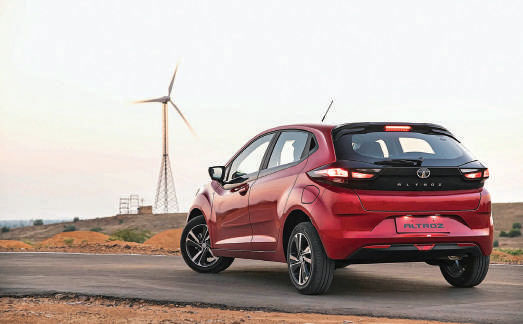TATA MOTORS
ANNUAL REPORT
2019-2020
Environmental Responsibility
Environmental Responsibility
Moving towards a
sustainable future
The Tata Motors Group takes precautionary measures for averting environmental risks and ensures compliance with applicable regulations.

Guided by the Group’s strategic priorities, the automotive businesses have taken several measures at all their manufacturing sites. They are also strongly focused on product innovations that improve eco-efficiency of the vehicles’ operational life.
TML in India drives all its initiatives on sustainability under the guidance of the Board committee on Safety, Health and Sustainability (SHS). All its operations are uniformly guided by the Tata Code of Conduct, which encompasses the principles of Reduce, Recycle, Recover and Refurbish. The Safety, Health and Environment (SHE) Councils at the business level, supported by the SHE Apex Committee at the plant level, are responsible for reviewing the performance every month. All TML plants are responsible for the implementation of energy, environment, and occupational health and safety management programmes.
JLR’s Destination Zero mission for zero emissions, zero accidents and zero congestion is built on the solid foundations of a longstanding commitment to the environment and society. Today’s industrial revolution is driven by waste reduction, decarbonisation, improving air quality, increasing automation and advancing technology. JLR plans to use resources responsibly to help build a better society and a cleaner environment – and in doing so, drive sustainable, profitable growth.

Energy and GHG emissions management
The automobile industry is energy intensive and the associated GHG emissions make it extremely important for our Group companies to chart out a long-term plan for minimising emissions and combatting climate change.
Tata Motors Limited
Energy conservation measures have been undertaken across the seven manufacturing plants of TML. They comprise process improvements, instrument replacements, and installation of energy efficient equipment, among others.

Energy efficiency FY20
SCOPE 1
ABSOLUTE EMISSIONS
(tCO2)
60,533
SPECIFIC EMISSIONS
(tCO2/VEHICLE)
0.13
SCOPE 2
ABSOLUTE EMISSIONS
(tCO2)
2,66,200
SPECIFIC EMISSIONS
(tCO2/VEHICLE)
0.56
SCOPE 3
PURCHASED GOODS AND
SERVICES1 (tCO2)
3,77,590
FUEL AND ENERGY
RELATED (tCO2)
77,073
UPSTREAM TRANSPORTATION
& DISTRIBUTION (tCO2)
16,342
BUSINESS TRAVEL
(tCO2)
8,865
EMPLOYEE COMMUTING
(tCO2)
11,286
USE OF SOLD PRODUCTS2
(tCO2)
26,44,749
FRANCHISES
(tCO2)
2,155
UPSTREAM LEASED ASSETS3
(tCO2)
2,801
1 This includes the emissions from supply chain and embedded emissions of raw materials. For the first time, embedded emissions from raw materials have been reported.
2 Emissions from PVs.
3 For the first time, the emissions from Company offices other than plants have been reported, covering around 37% of TML's leased properties.
- Corporate Overview
- Company Profile
- Chairman’s Message
- TML CEO and MD’s Message
- JLR CEO’s Message
- New Launches
- Key Highlights
- Performance Review
- Business Model
- Operating Environment
- Risks and Opportunities
- Stakeholder Engagement and Materiality
- Tata Motors Limited – Turnaround 2.0
- Jaguar Land Rover – Transformation
- Tata Motors Finance
- Sustainability Focus
- Environmental Responsibility
- Social Responsibility
- Corporate Governance
